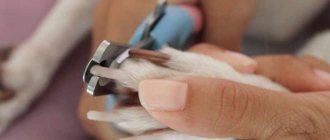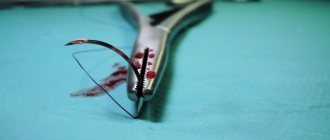One of the most discussed issues among dachshund owners is spaying and neutering their pets. Many people think that the term castration refers to male dogs, and the term spaying refers to female dogs.
However, this is not an entirely correct opinion. Castration is an operation involving the complete removal of the gonads: the ovaries in females and the testes in males. Sterilization eliminates the possibility of having offspring, but the sexual instinct and associated behavior remain the same as in dogs that do not undergo this operation.
When sterilizing a female, the oviducts are simply ligated, and when sterilizing males, the vas deferens are ligated. Most often, dogs are spayed rather than neutered. A common reason for this operation is not simply the reluctance or inability to allow the dachshund to be bred, but the elimination of problems associated with sexual behavior. In the case of sterilization, problems such as urine marking in the house, aggression towards dogs and people, and cages are not eliminated.
Only castration makes the dog calmer and, in a sense, more convenient for keeping in a city apartment. Castration does not affect the dog's mental abilities; on the contrary, it makes it calmer and more receptive to training. This is confirmed by the fact that professional guide dogs for the blind are necessarily neutered, but they perform their duties responsibly and are distinguished by their intelligence and intelligence.
Pros and cons of spaying and neutering procedures for dachshunds
You can always find supporters and opponents of sterilization and castration. Proponents say these surgeries are beneficial for dachshunds, especially since female dachshunds are at risk for breast cancer. If surgery is performed before 2.5 years of age, the risk of this common disease is significantly reduced.
It is generally accepted that males tolerate spaying and castration better than females. The main selection criteria for surgery should remain medical indications, and not just the desire of the owner. Medical indications include:
- frequent heats,
- false pregnancy,
- difficult childbirth due to physiological characteristics or infection,
- alarming behavior in male dogs.
There is an interesting opinion that in the conditions of a modern city, uncastrated males constantly experience stress associated with the presence of a large number of stimuli for the sexual instinct. For example, a male dachshund lives in an area where a large number of female dogs who go into heat live with him.
Every time he goes for a walk, he receives powerful surges of hormones, which are stressful for his body. The male will suffer, lose his appetite, and in general such a sexual attack will shorten his life and negatively affect his health. A castrated male will be protected from such troubles.
If a dachshund bitch does not tolerate heat well, becomes aggressive, eats poorly, or behaves inappropriately, then these are alarming signs that can develop into a serious illness. Therefore, in this case, it is also recommended to undergo surgery so as not to torture yourself and your pet. Of course, a lot depends on the value of the dog as a producer of offspring, but sometimes nature makes its own adjustments.
For example, a bitch, which was planned to be used for breeding, becomes ill with an infectious disease of the genitals and has to have them removed. It is difficult to judge the moral aspect of this operation. Opponents of castration and sterilization believe that these operations do not allow dachshunds to live a full, happy life. Of course, it is doubtful that a dog will feel inferior if it does not have offspring, in this sense people tend to transfer their views to dogs.
A bitch who has not given birth feels no less happy than one who has given birth, especially since the inevitable separation from puppies is additional stress for the dog. Also, opponents of the operation argue that removal of the genital organs leads to hormonal imbalances, and the dog will need to be fed hormonal drugs for the rest of its life.
Owners of dachshunds who have undergone castration claim that this is not the case, and that after the operation they feed their pets regular food without added hormones. Supporters of purebred dachshund breeding are also in favor of carrying out such operations. They believe that this is the only way to protect dogs and their owners from unscheduled matings and the birth of mixed breeds.
When is the best time to have surgery?
In principle, sterilization of females and males can be carried out at any age, but it is advisable to do this before 1 year in males, and before the first heat in females. This will reduce the likelihood of gynecological diseases in females, and males will not have time to develop bad habits.
The decision to spay and neuter a dachshund should be a balanced and thoughtful one, and not a momentary desire of the dog owner. He must weigh all the pros and cons in a particular case, and take responsibility for all the consequences of the operation or, conversely, for refusing it.
It is important to know at what age dogs are neutered, because the age at which the operation is performed can affect the future condition of the pet.
Out of age indications for dog castration
Why do you need to neuter your dog? The hormonal levels of cables are never stable. It usually depends on the amount of hormones that the testes produce. It is for this reason that males are eager to mate at any time of the year.
Note! Unlike females, males show the greatest aggression and drive during puberty. At this time, any dog that finds itself on the street makes marks, attacks other cables, and tries to make acquaintances with female dogs.
Increased activity and sexual desire of a pet, at some point, can become a serious problem for the owner and for the dog himself. If the owner does not have the opportunity to provide his pet with regular mating with females, then the best option would be to castrate the male.
Castration will help get rid of such unpleasant phenomena that occur in male dogs during sexual exacerbation:
- desire decreases;
- the pet stops marking its territory;
- he becomes calm;
- aggression disappears;
- he does not attack other dogs and does not attack bitches on the street.
There are also a number of cases in which castration is recommended:
- if the dog shows frequent attempts to sort things out with other males. Manifestations of increased nervousness may be associated with increased testosterone production;
- strong marking behavior. It is expressed in the fact that the male tries to mark everything around, including pieces of furniture, corners;
- if the pet constantly strives to run away from home in search of a female for mating.
Sometimes castration may not be necessary; upbringing has a lot to do with it. If a pet behaves provocatively, its attempts can be stopped at the initial stage. But it is worth considering that unsatisfied sexual need can lead to increased aggression and disobedience of the animal.
In some situations, castration may be prescribed according to indications. The most important ones include:
- the presence of an inflammatory process in the genital organs;
- injuries;
- oncological pathologies;
- genetic diseases;
- Some veterinary experts recommend surgical intervention as a preventive therapy for serious diseases that may appear in the pet in the future.
Find out more about dog neutering.
Optimal age for castration of dogs
Many dog owners often have a question: at what age can dogs be neutered? The optimal period for this operation is considered to be the beginning of puberty. At this time, the body is fully formed, but sexual desire has not yet had time to take over.
At this time, the dog has not yet begun to make marks wherever possible. Veterinarians recommend castration before the onset of this harmful habit. Otherwise, it will be difficult to get rid of it in the future.
It is not at all necessary to castrate the puppy; this procedure is also suitable for older males, and it will not cause complications for them. Sometimes the owners themselves postpone the operation, hoping that the dog’s unpleasant symptoms will go away on their own, namely, that the dog will lose its temper and everything will return to normal.
Important! Many veterinarians argue that first of all you need to pay attention not to the age of the dog, but to his well-being and condition. It is better to castrate an elderly and healthy dog than a young and sick one.
It is worth considering that castration of a male dog at a young age is a dangerous procedure. Of course, early castration has its advantages - the puppy will recover faster, the animal will quickly forget the stress it experienced.
However, there are many more disadvantages:
- the operation will definitely require anesthesia, which will be difficult to calculate;
- pathologies of the genitourinary system may appear in the future;
- possible development of urolithiasis;
- During the growth and development of a young body, various health problems may appear.
The age of castration may also depend on the breed. For small breeds it is recommended to carry it out from 6-7 months, but for giants much later - at a year and a half.
Read also
Cystitis in dogs: symptoms and treatment
Cystitis is a type of genitourinary tract infection that affects the bladder
Fleas on a dog. How to withdraw?
Fleas can cause a lot of discomfort and suffering to your animals, but they must be removed very carefully
Worms in dogs: Signs, symptoms and treatment
The presence of worms in domestic dogs is a widespread phenomenon. Many worms found in our animals are also dangerous for humans.
Ear mites in dogs: Symptoms and treatment of otodectosis
Otodectosis or ear scabies is a chronic invasive disease caused by microscopic itch mites.
Proper nutrition for dogs. Diet selection from a veterinarian
In order for your dog to be healthy, active and live for many years, you need to choose the right diet in combination with physical activity and vaccinations.
Methods of castration of dogs
We have figured out when it is better to castrate, now it is worth finding out what methods of castration are used for male dogs. There may be several of them; each has some features that must be considered.
Surgical
Surgical castration is a simple procedure that has been used for quite a long time. After it, dogs live much longer, do not experience severe stressful situations, and they are also less susceptible to many dangerous pathologies - oncology, transmissible sarcoma, which is accompanied by foul-smelling growths on the mucous membrane of the genital organs (it is transmitted through sexual contact).
Before the procedure, the dog is given anesthesia so that it cannot feel pain or other unpleasant sensations. The veterinarian also places her in the required position. After this, the operation begins, which can be carried out using several methods:
- open method. During it, the wall of the scrotum above the testis is grabbed, then the skin is dissected along the middle seam, the vaginal membrane is opened and the testis is removed from the vaginal sac using pressure. Next, the mesentery of the testis is divided, and the vessels and vas deferens are ligated. The second organ is removed through an incision in the same way;
- private method. During it, the skin of the scrotum is incised, then the vaginal sac is removed and the contents are removed from the cavity. The section of the spermatic cord is freed from the fascia and ligated. A clamp is placed distal from the ligature and the cord is divided. Next, the second testis is brought to the incision, and all steps are repeated.
Chemical
Chemical castration is considered to be a temporary cessation of reproductive functions in a dog. It is mainly used for guard, service, and hunting breeds. It can also be used as an alternative for weak, sick animals.
Infertility usually occurs 5-7 weeks after administration of the drug; it can last for 6-7 months.
It is not recommended to use contraceptives for a long time. The fact is that many of them have a number of side symptoms that can negatively affect the condition of the animal.
Learn about the rules for caring for your dog after castration.
Chemical and surgical castration have no differences in requirements in terms of the age of the dog.
When it comes to castrating a male dog, most owners react negatively. It seems pointless to them to put their pet at risk on the operating table. Why deprive your pet of his masculinity if he:
- will not bring puppies in the hem;
- does not mark indoors, unlike a cat.
While the owners of bitches worry about the health of the uterus and mammary glands, the owners of male dogs breathe a sigh of relief and do not rush to the surgeon. And in vain. There are situations when castration is necessary for medical reasons.
I will try to explain in detail why every veterinary surgeon encroaches on the “household” of your dog. Spoiler: not for profit. Regarding the well-being of the pet, castration of a male dog has both pros and cons. Only after weighing all the pros and cons yourself, you can decide with peace of mind whether to castrate the dog, and at what age.
Some owners are terribly worried that after surgery their pet will become an “inferior” asexual creature. And we are sure that other dogs will begin to despise their relative. The source of such reasoning is the humanization of animals, which we all sin to one degree or another.
I'm sexy and I know it!
It should be admitted: a castrated male differs from an uncastrated male in only one thing: the level of testosterone in the blood. This entails both pros and cons.
—
Why should you contact Dr. Vetson?
Traumatology and surgery are the core areas of our work. We carry out diagnostics using modern equipment. Surgeons approach the solution of the problem individually. All nuances are taken into account.
The clinic has its own hospital. Your pet can stay for free for 12 hours after surgery. During this period, prescribed procedures may be carried out. At the same time, the dog’s condition is constantly monitored.
Specialists Dr. Vetson perform operations of varying complexity. A team of surgeons is on duty at the clinic around the clock to perform emergency procedures. Anesthesia is selected by an experienced anesthesiologist who continuously monitors the animal’s condition during surgery.
Animals are given safe anesthesia. This is an inhalation (gas) composition that provides a high degree of controllability. At the end of the procedure, intradermal sutures are applied. They do not require removal later. Therefore, the animal recovers much faster.
Medical indications: 3 situations when castration is necessary
There is nothing unnecessary in the body - the main argument of opponents of castration. This is true. The problem is that in nature, canines live on average 6-8 years. And our pets last much longer, 10-16 years. And with age, some earlier and some later, diseases associated with the activity of the testes arise. The only treatment and the only prevention is castration.
Oncology
Neoplasms of the testes are a common occurrence in older dogs over 7-8 years of age. There are several types of testicular tumors:
- Sertolioma.
This is a tumor consisting of special Sertoli cells. It produces female sex hormones - estrogens. It is with this “feminization” that the symptoms are associated:
- Symmetrical baldness on the sides, neck, armpits. At the same time, the dog does not itch, there is no inflammation or scratching.
- The skin becomes thin and dark.
- The dog can become an object of sexual interest among other males, but he himself does not show activity when meeting a female in heat.
- The penis becomes smaller and the skin of the prepuce sag.
Sertolioma is insidious in that it does not always cause testicular enlargement. It can be difficult for a doctor to convince the owner of the need for surgery and subsequent histological examination of the removed testis. The evidence base in this case is ultrasound of the testes and determination of hormone levels in the blood.
- Seminoma.
This tumor consists of the epithelium of the seminiferous tubules. The average age of onset of seminoma is 10 years. The tumor can behave as benign; it rarely metastasizes. However, it increases in size rapidly and requires urgent surgical intervention.
Seminoma on the left, unaffected testicle on the right
Malignant tumor of the testis
- Leydigoma.
With a Leydig cell tumor, the amount of testosterone in the body begins to go off scale. This leads to an enlarged prostate and tumors around the anus. Perianal tumors can be either benign (adenomas) or malignant (adenocarcinomas).
Prostatitis
Prostatitis occurs in uncastrated male dogs older than 5-7 years. Benign enlargement of the prostate gland in a male dog goes unnoticed for a long time. Only an advanced form of prostatitis causes difficulty urinating and defecating. Prostate infections produce small amounts of pus or blood in the urine. Regular mating prevents congestive prostatitis, but it is impossible to ensure it throughout life.
Treatment of prostate adenoma or bacterial prostatitis begins with surgical or chemical castration. A decrease in testosterone levels causes almost complete atrophy of the gland within 3 months after surgery.
Much more dangerous is prostate adenocarcinoma, a malignant tumor of the gland. In this case, treatment is almost impossible. Not every surgeon will undertake to remove the entire prostate followed by reconstruction of the urethra (urinary canal). But even such a complex operation will not protect against the occurrence of metastases.
When I see a patient like this, I can't stop thinking that castration at a young age would have protected him from prostate tumors.
Perineal hernia
When the prostate enlarges more and more, and the owners do nothing, the result is the same - a perineal hernia. A huge gland mechanically presses on the intestines. To defecate, the dog strains hard. As a result, the weak muscles of the perineum creep apart and the organs of the pelvic cavity fall out under the skin. In the hernial sac, which looks like a huge tumor to the right or left of the anus, there may be: prostate, bladder, intestinal loops. If any organ is injured, the dog may die.
Perineal hernia in a Yorkie
Perineal hernia repair is a long and labor-intensive operation. But despite this, the surgeon must also perform castration, otherwise the root cause of the disease will not be eliminated.
Post-operative care
No matter how simple the procedure may be considered, it is still a surgical intervention and stress for the animal. After sterilization of dogs, care for tailed patients should be carried out according to all the rules. The owner is obliged to provide the pet with the appropriate conditions:
1Comfortable sleeping place, which is a soft bedding on a flat floor. 2 Avoid drafts and overheating; the dog should be warm. 3After anesthesia, the animal becomes thirsty; you can give it a cup of clean water. 4Feeding is allowed only from the next day after the procedure. 5 The diet consists of soft food: pates, minced meat, wet ready-made food. 6For 10 days after surgery, it is necessary to take care of the suture and treat it with antiseptics. Make sure that the dog does not chew the seams (you can wear a plastic collar or protective blanket). 7It is imperative to complete the full course of medications prescribed by the veterinarian to prevent the development of postoperative infections.
If your pet has no appetite, vomiting, or purulent discharge or blood from the suture, contact your veterinarian immediately. Our center provides an emergency call to an experienced specialist, even at night.
Is it necessary to castrate a cryptorchid?
I often hear the following phrase: “Remove the testis that has not descended, and leave the other one.” For what, for beauty? After all, you can’t breed a male! "We want him to remain a man." I refuse to carry out such an operation, if castrate, then with the removal of both testes!
The temperature in the scrotum is 3-4°C lower than the body temperature in the abdominal cavity. This is necessary for normal sperm formation. The testis, which is constantly overheated, eventually degenerates with the appearance of a malignant tumor. If in an ordinary male the average age of detection of seminoma is 10 years, then in a cryptorchid it is 5-6 years.
Testicular tumor in a 9-year-old Jack Russell
Tumor of the testis located in the groin area
If the testicle is not located under the skin in the groin area, but in the abdominal cavity, then the danger increases many times over. Owners do not see changes in the size of the testis, and the tumor manages to metastasize. And most importantly, torsion of the testis on the vascular pedicle is possible. This causes sharp pain (acute abdomen), the cause of which the therapist may be looking for in the “wrong place.”
The operation to lower the testis into the scrotum and fix it in it in the Russian Federation is recognized as illegal (fraud) and should not be carried out. Cryptorchidism is a direct indication for castration, which will not prevent a male dog from living a long, fulfilling life.
Sometimes an undescended testis can be easily felt under the skin
Two stitches after castration of cryptorchid
At what age is a male dog castrated?
There is no optimal age for castration. One thing is clear: it must be a young, healthy animal. With current vaccinations, free of parasites, in optimal physical shape.
Since the puppy receives the second vaccination at 3 months of age or older, castration before 4 months is not indicated. And early castration is not accepted in Russia. From 4 to 6 months, teeth actively change and bones grow rapidly. Sexual behavior is not yet a concern for owners.
Therefore, I consider the best age for castration of a male dog to be between 7 and 12 months. The testes are small and “tender”, so the incision is tiny and the suture heals quickly. In miniature dog breeds, at the same age, milk teeth that have not been replaced on their own are removed. These procedures can be performed under one general anesthesia.
Most often, male dogs are referred for castration at the age of 1.5-4 years. By this point, it becomes clear how promising the manufacturer’s career is and whether behavior correction is required. There is no upper age limit. Older dogs have to take operational risks for medical reasons. Another question is that the wear and tear of the body and chronic diseases add work to the anesthesiologist.
The owners would not agree to castrate this Jagd Terrier under any pretext.
I recommend castrating an abdominal cryptorchid as early as possible. Although the owners promise to appear for an ultrasound of the “hidden” testis at least once every six months, in fact it is often left unattended. And already at 4 years old there is a real risk of developing cancer. Why take the risk?
If both testes are in the scrotum, starting from the age of 4-5 years, you need to do an ultrasound of the prostate. And castrate a male dog at the first signs of congestive prostatitis.
Castration of a male dog: cons
If people were confident in the beneficial effects of castration on a pet’s body, this operation would be performed much more often. But the fact is that castration of a male dog does not have any negative effects. There are some things that still confuse me though:
Tendency to obesity
The male sex hormone (testosterone) is a powerful fat burner that accelerates metabolism and supports the growth of muscle rather than fat tissue. After castration, testosterone levels decrease, which increases the dog's tendency to become obese. Plus, the male stops chasing females in heat, refusing to eat. He does not sit for a week in a row in front of someone else’s entrance, where the “lady of his heart” lives.
I often meet fat, uncastrated males. And even more often – slender, athletic, sterilized dogs. The secret is that fat does not come from thin air! It is enough to feed the dog correctly so that castration does not affect the weight in any way.
A castrated male gets fat for the same reason as a fertile male. The owners feel sorry for him and slip tidbits from the table, without devoting time to active games and walks.
Diet and an active lifestyle allow your dog to stay in shape after castration.
Operational risks
If a veterinarian says that castration of a male dog is an absolutely safe procedure, he is lying. At a minimum, the operation is performed under general anesthesia, and this is a certain risk. Errors during the operation cannot be ruled out, although an experienced surgeon practically never makes them. We are talking about bleeding that occurs if a ligature comes off a vessel feeding the testis.
Bleeding can also occur from skin vessels. At risk are dogs with bleeding disorders. There are hereditary diseases, such as von Willebrand disease, which can cause your pet to bleed to death. If the breed is at risk, like Bernese Mountain Dogs, a genetic test should be done before surgery.
Before castration, the animal is not only examined, but also examined. For young male dogs, it is enough to do:
- Cardiogram (ECG);
- Clinical blood test;
- Blood clotting test.
For older animals, the list is expanded at the discretion of the doctor:
- ECHO of the heart (this study does not replace an ECG);
- Biochemical blood test (anesthesia can worsen renal failure);
- Ultrasound of the abdominal cavity, kidneys, prostate.
Anesthetic risks are significantly higher for dogs of brachiocephalic breeds.
The owner must be aware of operational risks - not to be afraid of the operation. And in order to properly prepare for it and choose a clinic wisely.
There are no absolute contraindications to castration. To those who say with a sigh, “ours is too old and won’t survive the operation,” I want to say one thing: old age is not a diagnosis! Options are always possible. If castration is necessary for medical reasons, and the animal has serious heart or kidney failure, Suprelorin is used. This is a subcutaneous chip that releases hormones that block the functioning of the testes.
Read more about chemical castration of a male dog HERE (the article will open in a new tab)
Complications after castration of a male dog
Castration of a male dog is not an abdominal operation (unless we are talking about abdominal cryptorchid). Complications after the intervention are rare. The most common problems:
- Inflammation and suture dehiscence;
- Severe swelling of the scrotum.
Complications are always associated with a violation of the surgical technique or care during the recovery period. These problems are discussed in more detail in a separate article.
Labrador Retriever Doesn't Like a Collar, But It's Necessary
What it is?
Castration is a manipulation during which the sex glands (testicles) are removed. As a result of such intervention, hormones that contribute to reproductive function cease to be produced. The operation is not dangerous and is not difficult compared to sterilization.
By the way, many dog breeders think that castration is indicated mainly for males, and only females are sterilized. But this is not true. Sterilization involves ligating: for some, the fallopian tubes, for others, the seminal ducts. In medicine, this technique is called a vasectomy. In sterilized individuals, the genitals remain intact and continue to produce hormones. They remain endowed with all reproductive functions, except the ability to have offspring.
This type of surgery is performed under general anesthesia. The dog in front of her must not eat anything for 12 hours and be healthy. The manipulation lasts about 20-40 minutes. It is practically safe, negative consequences after it occur infrequently.
As for the harmfulness of such a procedure, you need to know that dogs by their nature are designed to live in a pack. And reproductive functions there are not predetermined for everyone, but only for individual individuals. Therefore, scientists claim that the use of such a technique does not have a negative impact on the psycho-emotional and physical development of the dog.
Important! A technique such as castration, in addition to reducing sexual activity and changing the dog’s behavior, no longer has any effect on its body.
On the contrary, an unneutered dog is more stressed when a physiological need is not met. In addition, this condition can provoke certain diseases of the genital area. But excessive activity can also cause harm. Thus, homeless females usually reward males with venereal sarcoma. Often dogs undergo this surgery due to traumatic lesions, tumors and other problems.











